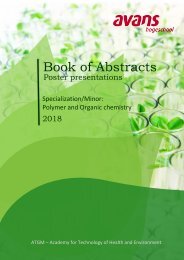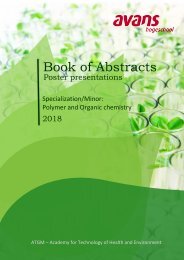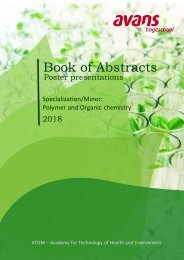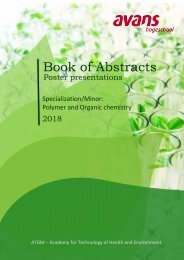Book of abstracts version 5
You also want an ePaper? Increase the reach of your titles
YUMPU automatically turns print PDFs into web optimized ePapers that Google loves.
Chemical recycling to Oxazolines<br />
Author<br />
Ian Bouwmeester<br />
Academy <strong>of</strong> Technology for Health and Environment<br />
Avans Hogeschool, Breda<br />
Jack van schijndel<br />
Abstract<br />
Many s<strong>of</strong>t drinks are drunk from Polyethylene Terephthalate (PET) bottles. PET is made with terephthalic acid and<br />
ethyleen. This substance is extracted from petroleum oil and petroleum is very polluting, so It is necessary to recycle PET<br />
so that this bottle production can continue without pollution. [1]<br />
To be able to produce a 100% recycled PET bottle we need to look at chemical recycling because it does not affect the<br />
chain length <strong>of</strong> the polymer. In this study PET is converted by aminolysis to bis (2 -hydroxyethylene) terephthalamide<br />
(BHETA) where BHETA can be converted to 1,4-bis (4,5-dihydro-3H-1,3-oxazin-2-yl) benzene (PBOx5). In addition to the<br />
use <strong>of</strong> PET, this study looks into whether an oxazoline can be made from PLA (PolyLacticAcid). [2] [3]<br />
to make PBOx5 first step is to make BHETA from PET in the reaction ethanolamine and catalyst is used. In this sub -study it<br />
is investigated whether a catalyst has a positive influence on the yield <strong>of</strong> BHETA. In addition, it is examined with which<br />
method the highest yield can be achieved. A microwave reflux synthesis varied between 5 to 8 minutes is compared with<br />
a 5 hours reflux. In the reaction <strong>of</strong> BHETA to PBOx5 two catalysts are compared thionyl chloride and oxalyl chloride in 18<br />
hour stir reaction. PLA reaction is done with the same method as PET<br />
The maximum yield is expected to be the microwave synthesis <strong>of</strong> 7 minutes in addition, thionyl chloride is expected to<br />
generate the highest yield <strong>of</strong> PBOx5. It is also expected that it is possible to make PLA an oxazoline.<br />
Keywords: Oxazoline, PET, PLA<br />
Table <strong>of</strong> content<br />
Figure 12:Reaction <strong>of</strong> PET to PBOx5.<br />
[1] N. Pingale en S. Shukla, „Microwave-assisted aminolytic depolymerization <strong>of</strong> PET waste,” European Polymer Journal, p.<br />
2695–2700, 2009.<br />
[2] G. M. M. S. Sadeghi en M. Sayaf, „From PET Waste to Novel Polyurethanes,” Material Recycling – Trends and<br />
Perspectives, pp. 357-363, 2012.<br />
[3] R. V. Shah, V. S. Borude en S. R. Shukla, „Recycling <strong>of</strong> PET Waste Using 3 -Amino-1-propanol by Conventional or,”<br />
natural <strong>of</strong> applied polymer science, 2012.<br />
43









